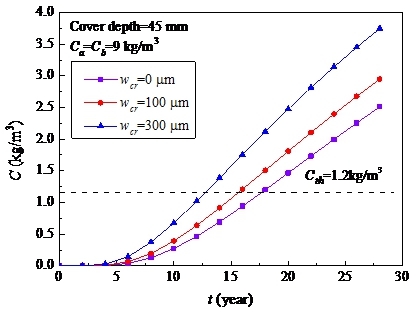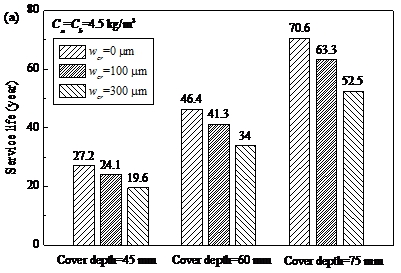Reinforced concrete (RC) pipe piles are increasingly applied in many fields of ocean engineering such as piers, bridges, off-shore platforms, port terminals, wharves, and harbors during the recent years. However, RC pipe piles served in marine environments are often exposed to serious chloride environment during their lifetimes. As chloride ions rapidly diffuse from the surfaces of RC pipe pile, through the concrete cover, toward the reinforcing steel, which may result in the accumulation of chloride content at reinforcing steel to chloride threshold level, so that high alkaline environment is destroyed and the passive film on the reinforcing steel surface is disrupted, then the steel corrosion is initiated. After initiation, corrosion of reinforcing steel propagates relatively fast, which may result in the reduction of the cross-sectional area of reinforcement, cracking, spalling and delaminating of concrete cover and the loss of bond strength between the steel and concrete, and finally leading to structural failure. To reasonably predict service life of RC pipe piles exposed to marine environments, many studies have been conducted on service life prediction of RC pipe piles associated with chloride induced deterioration by our research group.
1) Influence of exposure temperature on chloride diffusion in RC pipe piles exposed to atmospheric corrosion. The governing equation of chloride diffusion in RC pipe pile was derived and solved analytically by using the Bessel functions. The salt spray tests were set up to simulate the environment of atmospheric corrosion. Several series of RC pipe piles with three different water-to-cement ratios (0.30, 0.45 and 0.55) were exposed to 5% chloride salt spray for 32 days at the three levels of exposure temperatures. The chloride concentration profiles, surface chloride concentration, chloride diffusion coefficient and activation energy values of RC pipe piles with different water-to-cement ratios at different exposure temperatures were presented.
2) Effect of chloride binding in terms of different binding isotherms on service life predictions of RC pipe piles. Four typical chloride binding isotherms (i.e., null, linear, Langmuir, and Freundlich binding isotherms) were reviewed. The free and total chloride concentration profiles were presented for RC pipe piles exposed to submerged and splash zones after an exposure period of 5, 10 and 30 years, respectively. Further, The predicted service life of RC pipe piles exposed to submerged and splash zones for different binding isotherms was also presented.
3) Service life prediction of cracked RC pipe piles exposed to marine environments. An analytical method for predicting the service life of cracked RC pipe pile with considering the effect of cracks on the chloride diffusion was presented. The governing equation of chloride diffusion into RC pipe pile was described and solved analytically by using the Bessel functions. The equivalent chloride diffusion coefficient was derived based on the partition of chloride diffusion through cracked RC pipe pile. The threshold chloride content was estimated from a wide review of previous experimental studies. Furthermore, an application of the analytical method was demonstrated by predicting service life of cracked RC pipe piles exposed to marine environments.
The results of present study may offer as an important reference of maintenance, strengthening, or demolition to existing RC pipe piles laden in marine environments.
Objective
1) To evaluate the influence of exposure temperature on chloride diffusion in RC pipe piles exposed to atmospheric corrosion; and 2) to quantify the effect of chloride binding on service life by means of analytical and numerical solutions to the chloride diffusion equation in RC pipe piles exposed to two different exposure conditions; and 3) to derive the relationship between crack width and the equivalent diffusion coefficient and present an analytical method for predicting the service life of cracked RC pipe pile with considering the effect of cracks on the chloride diffusion.
Approach
Model tests and field tests, finite difference methods, Fick’s first, second law of diffusion, separation variable method and Bessel functions were adopted herein to estimate the service life of RC pipe pile with considering the effect of temperature, chloride binding and cracks on the chloride diffusion.
Significant Results and Potential Impact
1) The chloride concentration profiles, surface chloride concentration, chloride diffusion coefficient and activation energy values of RC pipe piles with different water-to-cement ratios at different exposure temperatures were presented; 2) The effect of chloride binding on the time-dependent chloride concentration profiles and service life was investigated by means of analytical and numerical solutions to the chloride diffusion equation in RC pipe piles exposed to two different exposure conditions; and 3) An analytical method for predicting the service life of cracked RC pipe pile with considering the effect of cracks on the chloride diffusion was presented.
Principal Investigator:
Jingpei Li, Fayun Liang, and Xiaoqing Yao.
Funding
National Natural Science Foundation of China (51178341).
Key Publication
(1) Wei Shao, Jingpei Li. Service life prediction of cracked RC pipe piles exposed to
marine environments. Construction and Building Materials, 2014, 64: 301-307.
(2) Jingpei Li, Wei Shao. The effect of chloride binding on the predicted service life of RC pipe piles exposed to marine environments. Ocean Engineering, 2014, 88: 55-62.
(3) Wei Shao, Jingpei Li. Prediction on corrosion initiation time of embedded steel in cracked PHC piles exposed to marine environments. China Civil Engineering Journal, 2014, 47(3): 123-129. (in Chinese)
(4) Wei Shao, Jingpei Li, Zhuwen Yue. Service life prediction of concrete pipe pile due to chloride ion corrosion by modeling. Journal of the Chinese Ceramic Society, 2013, 41(5): 575-581. (in Chinese)

Fig. 1. Schematic diagrams of Salt fog erosion test box.

Fig. 2. Predicted total chloride concentration profiles at 30 years corresponding to four different binding isotherms.

Fig. 3. Variable of chloride concentration at surface of reinforcement steel with time for Ca=Cb=9 kg/m3: (a) cover depth=45 mm.


Fig. 4. Effect of crack width on service life for different exposure conditions: (a) Ca=Cb=4.5 kg/m3 and (b) Ca=Cb=9 kg/m3.



